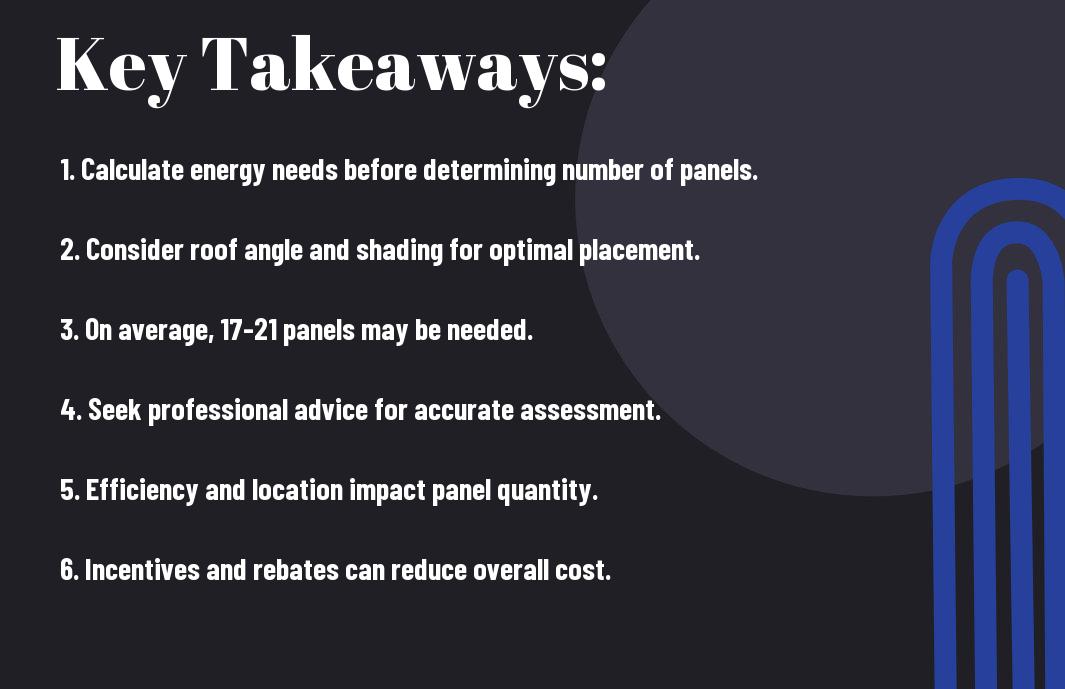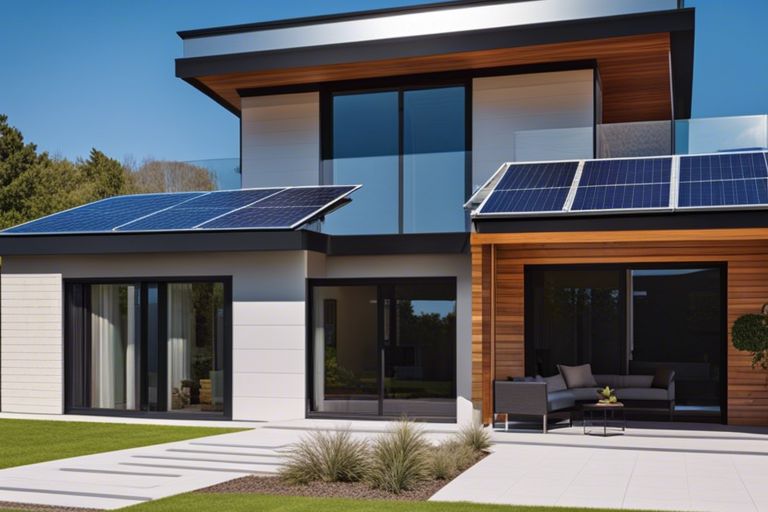Many factors come into play when determining the number of solar panels needed for your 2000 sq ft home. In this guide, we will break down the calculations and considerations you need to make to ensure you have an efficient and cost-effective solar energy system to power your home. By the end of this blog post, you will have a clear understanding of how many solar panels are required to meet your energy needs.
Key Takeaways:
- Calculate energy needs: Determine your average daily energy usage to determine the number of solar panels needed for a 2000 sq ft home.
- Consider efficiency: Take into account the efficiency and energy output of the solar panels to ensure they meet your home’s energy requirements.
- Consult with professionals: It is recommended to consult with solar energy experts to help you calculate the number of solar panels needed for your specific situation.


Determining Your Energy Needs
A crucial step in determining how many solar panels you need for your 2000 sq ft home is to calculate your energy consumption. This involves understanding how much energy your household uses on a daily basis and identifying the factors that affect your energy usage.
Calculating Your Energy Consumption
With a 2000 sq ft home, your energy consumption can vary depending on several factors such as the number of occupants, their daily routines, the type of appliances you use, and your heating and cooling needs. To get a rough estimate, you can look at your past energy bills to see how many kilowatt-hours (kWh) you typically use per month.
Factors Affecting Energy Usage
- The size of your home: A larger home will generally require more energy to heat, cool, and power.
- Energy-efficient appliances: Upgrading to energy-efficient appliances can significantly reduce your electricity consumption.
- Climate: If you live in a region with extreme temperatures, you may use more energy for heating or cooling.
Any changes you make to improve your home’s energy efficiency will impact the number of solar panels you need. Factors such as insulating your home, sealing air leaks, and using smart thermostats can all contribute to lower energy consumption and reduce your reliance on the grid.
- Thus, it’s imperative to consider these factors when calculating your energy needs and determining the right solar panel system for your 2000 sq ft home.
Assessing Your Roof’s Solar Potential
Roof Size and Orientation
Any successful solar panel installation starts with assessing your roof’s size and orientation. The amount of available roof space will determine how many solar panels you can install. Ideally, you want a roof that has enough unobstructed space to accommodate the number of panels needed to generate sufficient electricity for your 2000 sq ft home.
Shading and Obstructions
Roof shading and obstructions play a crucial role in determining your roof’s solar potential. Trees, buildings, or other structures that cast shadows on your roof can significantly reduce the efficiency of your solar panels. It’s necessary to assess the shading patterns throughout the day to ensure maximum sunlight exposure for your solar panels.
Avoid installing solar panels in areas that are heavily shaded or obstructed, as this can diminish the overall performance of your solar energy system. Make sure to trim any overhanging branches or remove obstructions that may impact the sunlight reaching your panels.

Sizing Your Solar Panel System
Calculating Your Solar Panel Requirements
Your first step in determining the number of solar panels needed for your 2000 sq ft home is to calculate your average daily energy consumption. This can be done by reviewing your utility bills to see how many kilowatt-hours (kWh) you use on average per day. Once you have this number, you can then calculate the size of the solar panel system required to meet your energy needs.
Considering Energy Efficiency Upgrades
Solar panels are a great way to generate clean energy, but optimizing your home’s energy efficiency can also help reduce the number of panels needed. Consider making upgrades such as installing energy-efficient appliances, improving insulation, and sealing air leaks. By reducing your energy consumption, you can lower the overall size and cost of your solar panel system.
With energy efficiency upgrades, you not only decrease your electricity usage but also make your home more environmentally friendly. These upgrades not only benefit the environment but also your wallet in the long run by reducing your energy bills.
Choosing the Right Solar Panels
Monocrystalline vs Polycrystalline Panels
Now, when it comes to choosing the right solar panels for your 2000 sq ft home, you may come across two common options: monocrystalline and polycrystalline panels. Any monocrystalline panels are known for their higher efficiency and sleek black appearance. They are made from single-crystal silicon, making them more space-efficient and perform better in low-light conditions. On the other hand, polycrystalline panels are made from multiple silicon crystals and are more affordable than monocrystalline panels.
Panel Efficiency and Durability
The panel efficiency and durability are important factors to consider when selecting solar panels for your home. The efficiency of a solar panel refers to how well it can convert sunlight into electricity. The higher the efficiency, the more electricity the panel can produce. The durability of the panel is crucial as it determines how long the panels will last and how well they can withstand harsh weather conditions. The right balance between efficiency and durability is necessary for ensuring the longevity and performance of your solar panels. The choice between monocrystalline and polycrystalline panels will depend on your budget and specific energy needs.
Plus, it is also important to consider other factors such as the manufacturer’s reputation, warranty, and certifications when choosing the right solar panels for your home. By carefully evaluating these factors, you can ensure that you select the best solar panels that will meet your energy requirements and provide a reliable source of clean energy for your 2000 sq ft home.
Installation and Configuration Options
Grid-Tied vs Off-Grid Systems
To determine the number of solar panels needed for your 2000 sq ft home, you will first need to decide between a grid-tied or off-grid solar system. With a grid-tied system, you remain connected to the utility grid and can benefit from net metering, selling excess electricity back to the grid. This option is great if you want to offset your electricity costs and potentially even earn credits on your utility bill. On the other hand, an off-grid system operates independently of the grid, requiring battery storage to store excess energy for use when the sun is not shining.
String Inverter vs Microinverter Configurations
Any solar installation will require you to choose between a string inverter and microinverter configuration. With a string inverter setup, all your solar panels are connected to a single inverter. This option tends to be more cost-effective but can be affected by shading issues. On the other hand, microinverters are installed on each individual solar panel, which optimizes energy production by reducing the impact of shading and panel orientation differences.
Another important consideration is the ease of monitoring and maintenance. With microinverters, you can monitor the performance of each panel separately, making it easier to identify and address any issues. This level of granularity can help you maximize the efficiency and lifespan of your solar panel system.
Local Regulations and Incentives
Despite the numerous benefits of installing solar panels on your 2000 sq ft home, it’s important to be aware of the local regulations and incentives that may impact your decision. Understanding the regulations in your area is vital to ensure that you comply with any requirements set forth by your local government or utility company.
Net Metering and Interconnection Agreements
On your journey to installing solar panels on your 2000 sq ft home, one key aspect to consider is net metering and interconnection agreements. Net metering allows you to send excess electricity generated by your solar panels back to the grid, receiving credits on your utility bill. Interconnection agreements dictate how your solar energy system can be connected to the grid, ensuring safety and efficiency. Be sure to check with your utility company to understand their specific policies and requirements.
Federal and State Tax Credits
The federal government and many states offer tax credits to homeowners who install solar panels. The Investment Tax Credit (ITC) allows you to deduct a percentage of the cost of your solar energy system from your federal taxes. State tax credits may also be available, providing additional savings on your solar panel installation. These incentives can significantly reduce the upfront cost of going solar, making it a more affordable and attractive option for your 2000 sq ft home.
The federal government currently offers a 26% tax credit for solar installations, but this incentive is set to decrease in the coming years. It’s important to take advantage of these credits while they are still available to maximize your savings on your solar panel project.
To
Make the most of these local regulations and incentives, be sure to research and understand what programs are available to you as a homeowner in your area. By taking advantage of net metering, interconnection agreements, and federal and state tax credits, you can make your solar panel installation on your 2000 sq ft home even more cost-effective and environmentally friendly.
Conclusion
Drawing together all the information provided, you now have a better understanding of how many solar panels you would need for a 2000 sq ft home. Recall, the number of panels required can vary depending on factors such as your location, the amount of sunlight your roof receives, and your energy consumption. It’s always best to consult with a solar expert to get a more accurate assessment for your specific needs.
By taking the time to calculate the right number of solar panels for your home, you can ensure that you are maximizing your energy savings and minimizing your environmental impact. Investing in solar panels is not only a smart financial decision in the long run but also a great way to contribute to a more sustainable future. So, if you’re considering going solar for your 2000 sq ft home, make sure to do your research, crunch the numbers, and reach out to professionals who can guide you through the process.
FAQ
Q: How many solar panels do I need for a 2000 sq ft home?
A: The number of solar panels needed for a 2000 sq ft home can vary depending on factors such as energy consumption, geographic location, roof orientation, and panel efficiency. On average, a 2000 sq ft home may require between 20 to 40 solar panels to cover its energy needs.
Q: What factors should I consider when determining the number of solar panels for my 2000 sq ft home?
A: Factors to consider when determining the number of solar panels for a 2000 sq ft home include the home’s energy consumption, roof size and orientation, sunlight exposure, local climate, panel efficiency, shading from nearby structures or trees, and any applicable local regulations or incentives.
Q: How can I determine the exact number of solar panels needed for my 2000 sq ft home?
A: To determine the exact number of solar panels needed for a 2000 sq ft home, it is recommended to consult with a solar energy provider or installer. They can assess your home’s energy needs, roof characteristics, and environmental factors to provide a customized solar panel system proposal that meets your specific requirements.
